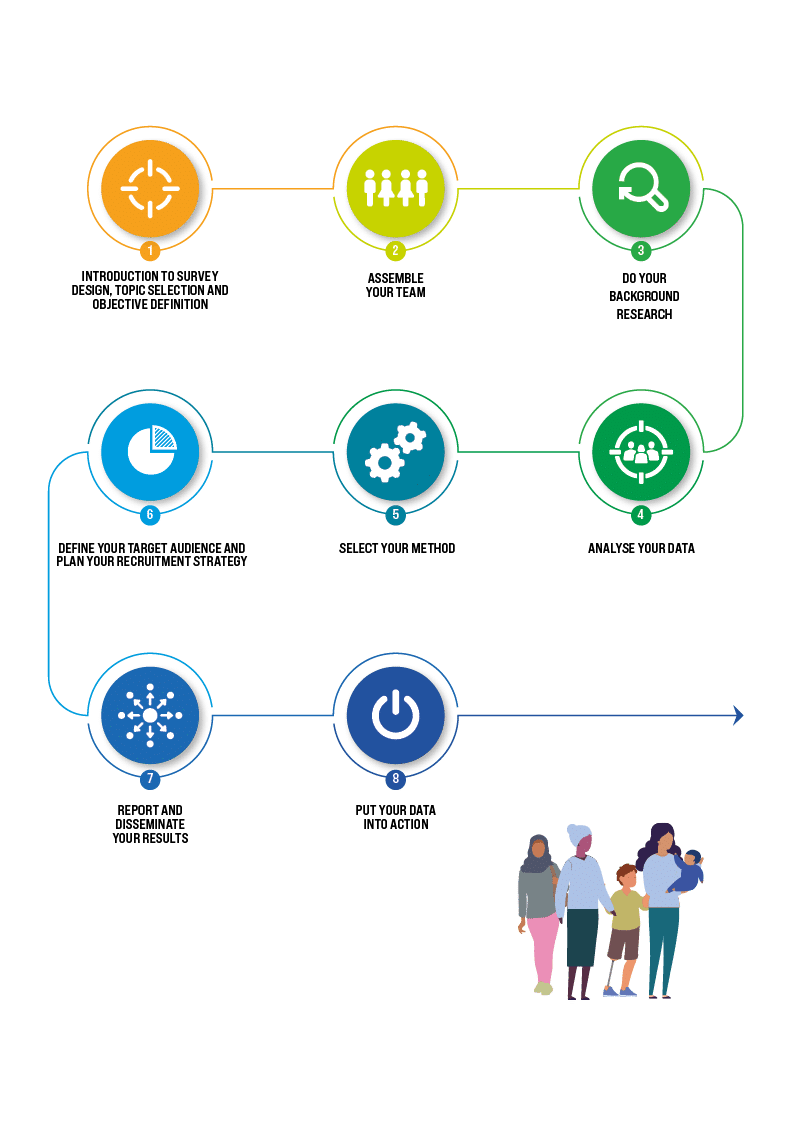Spread the word by using the Survey Design factsheet!
About Us
Rare Disease Policy
About Rare Diseases
About Medicines For Rare Diseases

Welcome to the Speak up. Listen up. Follow up e-toolkit: a resource hub for survey design that will help you unleash the power of data capable of influencing policymakers, driving research and improving health outcomes for your patient community!
This is a centralised resource hub gathering different and complementary materials on survey design. Here you will find a myriad of resources, including guides, videos, courses and other actionable materials, on all the hot topics related to survey design.
The e-toolkit is organised into 8 steps which correspond to the most important phases of any survey.
This one – stop, stepwise repository will help you to efficiently identify the resources you need while, simultaneously, giving you a methodological overview of survey design. This is a live platform, which means we will continuously feed this hub, adding new, relevant materials as we create and/or identify them.
Let’s begin, step-by-step!
Survey design follows a multi-step approach which involves several decisions, resources and partners. The first and often most decisive step when conducting any survey is deciding what you want to explore, i.e. selecting a topic, and establishing the purpose and intent of your survey, i.e. what you want to achieve in broad terms. Put some time into getting a better understanding of the entire survey design process before rushing into any decisions. Also, it is key you dedicate time to planning your survey, debating options and troubleshooting with your team. The resources below will provide you with some context, tips and guidance on how to move forward. They will be a useful place to start, so come on, take the first step!
Files
Courses
Designing an effective survey requires a varied set of skills and experience. Hence, assembling a multidisciplinary team, i.e. identifying and gathering people with the expertise you need and who will help you develop and deliver a successful project, is key in any survey. Take a look at the resources below - they will bring you some inspiration and real-life examples of the added value of putting together a winning team.
Avoid duplicating efforts & reinventing the wheel by doing your background research. You may be eager to start developing your survey, but before you do, take a step back and do some searching. Find out what reliable information and data are already out there. There are several helpful databases and trustworthy organisations that you can explore. You will probably find best practices you could replicate or tools you can adapt or use directly. It will cost you some time and effort, but it will pay off, as it will move you forward in the right direction. Learn more about how to conduct your background research and where to look for reliable information below:
Files
After defining your topic, setting your objectives and goals, assembling your team and conducting your background research, you are now ready to take the fourth step - defining who your target population is and designing your recruitment plan, i.e. how to reach out to them. There are many things you should consider in this step, from the characteristics you want your respondents to have (e.g. age, gender, nationality, disease) to the recruitment channels and materials you will develop and use to invite and persuade them to participate in your survey. It might not be an easy task, but the materials below could help you out:
Files
People’s insights on and feedback about their experiences, needs and priorities can be gathered in a wide range of ways – there is no one-size-fits-all approach. To decide which method you should use to survey your community, you should think about your objectives & goals, how you intend to use the data you will collect and to which method your target population would respond better to. Also, data protection and privacy are not only buzzwords. You should do everything in your power to ensure your survey is ethically sound, i.e. that you are respecting the rights and privacy of your respondents, regardless of the method you choose to survey your community. Explore the resources below to learn more about what types of methods there are, how and when to use them:
Data analysis is frequently seen as the hardest step to take when designing a survey. It is not totally unfounded, as it takes skill, knowledge and time to make the most of the insights & experiences you collect from your patient community. Hence, you should plan early and decide how, when and by whom your survey data will be analysed and interpreted. Browse through the materials below to find advice and access some empowering resources and trainings that will make you see data analysis and interpretation in a different light:
Remember that listening to your community is just half of the process. The data you gather and analyse needs to reach the people who will use the information to make decisions either at personal, institutional, country or international level. That is why the reporting and dissemination phase is a very important step of survey design. Make sure to always follow this motto: ‘communicate the right message, in the right format, through the right channels to the right people at the right time’. Find examples of different reporting formats and trainings below:
In this section you will find a gallery of diverse case studies showcasing different survey design methods and outcomes. We hope these real-life examples will inspire you, help you identify best practices and show you how you can put your data into action. Take the final step - the finish line is just around the corner!
Spread the word by using the Survey Design factsheet!